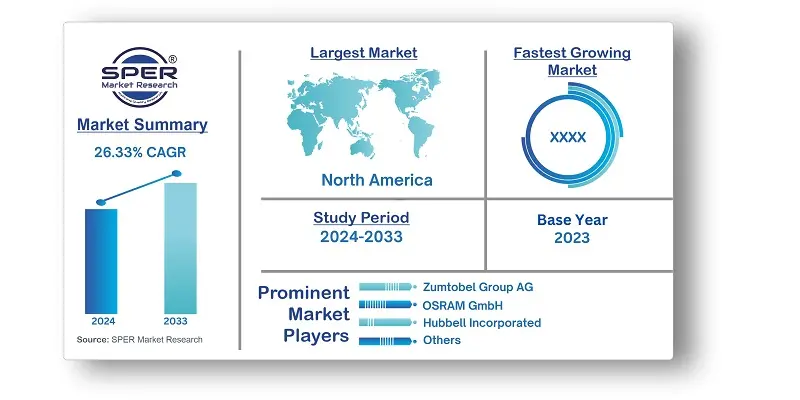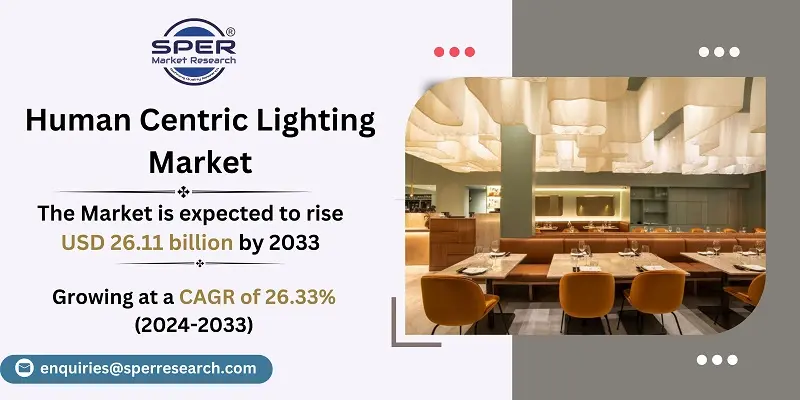
Human Centric Lighting Market Growth, Size, Trends, Demand, Share, Revenue and Future Outlook
Human Centric Lighting Market Size- By Component Type, Installation Type, By Application- Regional Outlook, Competitive Strategies and Segment Forecast to 2033
| Published: Apr-2024 | Report ID: SEMI2414 | Pages: 1 - 235 | Formats*: |
| Category : Semiconductor and Electronics | |||
- Legrand purchased Netatmo (France), a top smart home provider in France, in November 2018 in order to expand its product line with new, complementary, and highly potential linked home categories.
- The LXB Series Linear High-Bay luminaires, which provide best-in-class performance with improved efficacy, dependability, and an extended lifespan, were introduced by Cree in October 2018. These luminaires are perfect for high ceilings, warm environments, and prominent areas.


| Report Metric | Details |
| Market size available for years | 2020-2033 |
| Base year considered | 2023 |
| Forecast period | 2024-2033 |
| Segments covered | By Component Type, Installation Type, By Application |
| Regions covered | North America, Asia-Pacific, Latin America, Middle East & Africa and Europe |
| Companies Covered | Zumtobel Group AG, OSRAM GmbH, Hubbell Incorporated, Fagerhult Group, Eaton Corporation plc, Helvar, Glamox AS, Waldmann GmbH & Co. KG, Schréder Group, Coolon LED Lighting, ERCO GmbH, Nualight Limited, Zumtobel Lighting GmbH, LEDVANCE GmbH. |
- System integrators
- Suppliers and distributors
- Electronic and consumer electronics product manufacturers
- ODM and OEM technology solution providers
- Original equipment manufacturers (OEMs)
- Lighting control system manufacturers
- Lighting manufacturers
- Sensor manufacturers and distributors
- Raw material and manufacturing equipment suppliers
- Semiconductor and electronic component manufacturers and suppliers
- Others
| By Component Type: |
|
| By Installation Type: |
|
| By Application: |
|
- Global Human Centric Lighting Market Size (FY’2024-FY’2033)
- Overview of Global Human Centric Lighting Market
- Segmentation of Global Human Centric Lighting Market By Component Type (Sensors, Drivers, Microprocessor & Microcontrollers, Switches & Dimers, Transmitter & Receivers, Others)
- Segmentation of Global Human Centric Lighting Market By Installation Type (New Installations, Retrofit Installations, Others)
- Segmentation of Global Human Centric Lighting Market By Application (Wholesale & Retail, Enterprises & Data Centres, Residential, Educational Institutions, Healthcare, Industrial, Hospitality, Others)
- Statistical Snap of Global Human Centric Lighting Market
- Expansion Analysis of Global Human Centric Lighting Market
- Problems and Obstacles in Global Human Centric Lighting Market
- Competitive Landscape in the Global Human Centric Lighting Market
- Impact of COVID-19 and Demonetization on Global Human Centric Lighting Market
- Details on Current Investment in Global Human Centric Lighting Market
- Competitive Analysis of Global Human Centric Lighting Market
- Prominent Players in the Global Human Centric Lighting Market
- SWOT Analysis of Global Human Centric Lighting Market
- Global Human Centric Lighting Market Future Outlook and Projections (FY’2024-FY’2033)
- Recommendations from Analyst
1.1. Scope of the report1.2. Market segment analysis
2.1. Research data source2.1.1. Secondary Data2.1.2. Primary Data2.1.3. SPER’s internal database2.1.4. Premium insight from KOL’s2.2. Market size estimation2.2.1. Top-down and Bottom-up approach2.3. Data triangulation
4.1. Driver, Restraint, Opportunity and Challenges analysis4.1.1. Drivers4.1.2. Restraints4.1.3. Opportunities4.1.4. Challenges4.2. COVID-19 Impacts of the Global Human Centric Lighting Market
5.1. SWOT Analysis5.1.1. Strengths5.1.2. Weaknesses5.1.3. Opportunities5.1.4. Threats5.2. PESTEL Analysis5.2.1. Political Landscape5.2.2. Economic Landscape5.2.3. Social Landscape5.2.4. Technological Landscape5.2.5. Environmental Landscape5.2.6. Legal Landscape5.3. PORTER’s Five Forces5.3.1. Bargaining power of suppliers5.3.2. Bargaining power of buyers5.3.3. Threat of Substitute5.3.4. Threat of new entrant5.3.5. Competitive rivalry5.4. Heat Map Analysis
6.1. Global Human Centric Lighting Market Manufacturing Base Distribution, Sales Area, Ingredients6.2. Mergers & Acquisitions, Partnerships, Product Launch, and Collaboration in Global Human Centric Lighting Market
7.1. Global Human Centric Lighting Market Size, Share and Forecast, By Component Type, 2020-20267.2. Global Human Centric Lighting Market Value Share and Forecast, By Component Type, 2027-20337.3. Sensors7.4. Drivers7.5. Microprocessor & Microcontrollers7.6. Switches & Dimers7.7. Transmitter & Receivers7.8. Others
8.1. Global Human Centric Lighting Market Size, Share and Forecast, By Installation Type, 2020-20268.2. Global Human Centric Lighting Market Size, Share and Forecast, By Installation Type, 2027-20338.3. New Installations8.4. Retrofit Installations8.5. Others
9.1. Global Human Centric Lighting Market Size Value Share and Forecast, By Application, 2020-20269.1. Global Human Centric Lighting Market Size Value Share and Forecast, By Application, 2027-20339.2. Wholesale & Retail9.3. Enterprises & Data Centres9.4. Residential9.5. Educational Institutions9.6. Healthcare9.7. Industrial9.8. Hospitality9.9. Others
10.1. Global Human Centric Lighting Market Size and Market Share
11.1. Global Human Centric Lighting Market Size and Market Share, By Region (2020-2026)11.2. Global Human Centric Lighting Market Size and Market Share, By Region (2027-2033)11.3. Asia-Pacific11.3.1. Australia11.3.2. China11.3.3. India11.3.4. Japan11.3.5. South Korea11.3.6. Rest of Asia-Pacific11.4. Europe11.4.1. France11.4.2. Germany11.4.3. Italy11.4.4. Spain11.4.5. United Kingdom11.4.6. Rest of Europe11.5. Middle East and Africa11.5.1. Kingdom of Saudi Arabia11.5.2. United Arab Emirates11.5.3. Qatar11.5.4. South Africa11.5.5. Egypt11.5.6. Morocco11.5.7. Nigeria11.5.8. Rest of Middle-East and Africa11.6. North America11.6.1. Canada11.6.2. Mexico11.6.3. United States11.7. Latin America11.7.1. Argentina11.7.2. Brazil11.7.3. Rest of Latin America
12.1. Zumtobel Group AG12.1.1. Company details12.1.2. Financial outlook12.1.3. Product summary12.1.4. Recent developments12.2. OSRAM GmbH12.2.1. Company details12.2.2. Financial outlook12.2.3. Product summary12.2.4. Recent developments12.3. Hubbell Incorporated12.3.1. Company details12.3.2. Financial outlook12.3.3. Product summary12.3.4. Recent developments12.4. Fagerhult Group12.4.1. Company details12.4.2. Financial outlook12.4.3. Product summary12.4.4. Recent developments12.5. Eaton Corporation plc12.5.1. Company details12.5.2. Financial outlook12.5.3. Product summary12.5.4. Recent developments12.6. Helvar12.6.1. Company details12.6.2. Financial outlook12.6.3. Product summary12.6.4. Recent developments12.7. Glamox AS12.7.1. Company details12.7.2. Financial outlook12.7.3. Product summary12.7.4. Recent developments12.8. Waldmann GmbH & Co. KG12.8.1. Company details12.8.2. Financial outlook12.8.3. Product summary12.8.4. Recent developments12.9. Schréder Group12.9.1. Company details12.9.2. Financial outlook12.9.3. Product summary12.9.4. Recent developments12.10. Coolon LED Lighting12.10.1. Company details12.10.2. Financial outlook12.10.3. Product summary12.10.4. Recent developments12.11. ERCO GmbH12.11.1. Company details12.11.2. Financial outlook12.11.3. Product summary12.11.4. Recent developments12.12. Nualight Limited12.12.1. Company details12.12.2. Financial outlook12.12.3. Product summary12.12.4. Recent developments12.13. Zumtobel Lighting GmbH12.13.1. Company details12.13.2. Financial outlook12.13.3. Product summary12.13.4. Recent developments12.13.5. Company details12.13.6. Financial outlook12.13.7. Product summary12.13.8. Recent developments12.14. Others
SPER Market Research’s methodology uses great emphasis on primary research to ensure that the market intelligence insights are up to date, reliable and accurate. Primary interviews are done with players involved in each phase of a supply chain to analyze the market forecasting. The secondary research method is used to help you fully understand how the future markets and the spending patterns look likes.
The report is based on in-depth qualitative and quantitative analysis of the Product Market. The quantitative analysis involves the application of various projection and sampling techniques. The qualitative analysis involves primary interviews, surveys, and vendor briefings. The data gathered as a result of these processes are validated through experts opinion. Our research methodology entails an ideal mixture of primary and secondary initiatives.



Frequently Asked Questions About This Report
PLACE AN ORDER
Year End Discount
Sample Report
Pre-Purchase Inquiry
NEED CUSTOMIZATION?
Request CustomizationCALL OR EMAIL US
100% Secure Payment






Related Reports
Our Global Clients
Our data-driven insights have influenced the strategy of 200+ reputed companies across the globe.




















